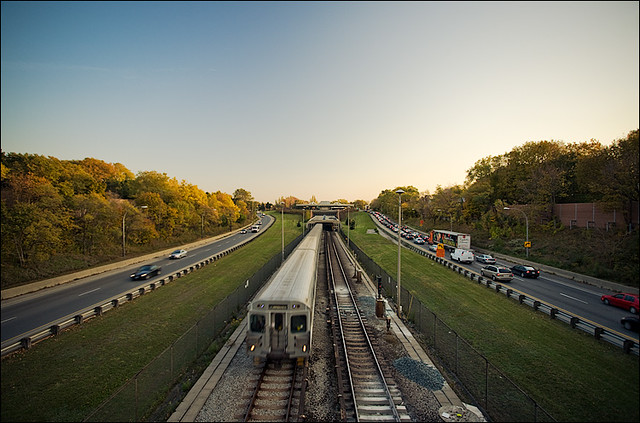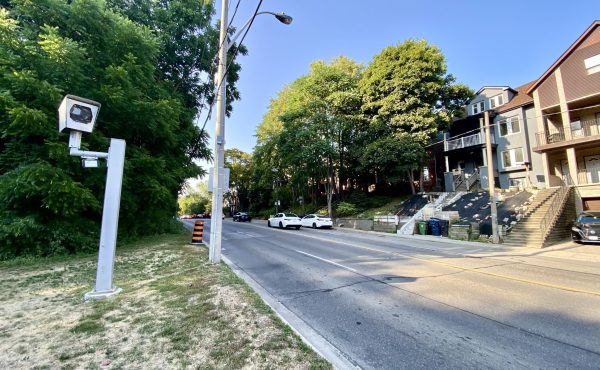
Plenty of attention has been paid to exploring the logistical and financial problems with Rocco Rossi’s proposal to build a tunnel for vehicle traffic from the Allen Rd. to the Gardiner Expressway.
But it’s also worth looking at Rossi’s underlying assumption about why the tunnel is needed. More car access to downtown Toronto is required, he says, because people have such a hard time driving to jobs in the downtown core. “Companies and workers would rather establish in the 905 than fight their way into downtown Toronto every day,” said Rossi. “I want our kids to have a chance to live and work at good jobs in the city of Toronto.”
The fact is, however, that despite the presence of both the Gardiner and the DVP feeding cars into the downtown core, only a minority of people who work downtown drive there. The vast majority — 71% — of people who travel into work downtown don’t have to fight their way through car traffic — they take GO Trains, the TTC, or they walk or cycle.
Here’s the breakdown for people commuting to Ward 28 (which includes most of the downtown business district) from outside the ward (all figures are from the Transportation Tomorrow Survey, 2006 (PDF)).
Local transit (TTC): 38%
GO Train: 26%
Walk/Cycle: 7%
Car driver/passenger: 28%
Other: 1%
The numbers are similar (more TTC, less GO Train) in Wards 27 and 20, which border the business district.
There’s no doubt that driving into downtown during rush hour is a pain, but if there is concern about commuters having a hard time getting downtown to work, it would benefit far more people — and increase the overall capacity of the transportation network much more — if the tunnel money was spent, instead, on enhancing rapid transit options to the downtown.
It’s also worth noting that, in fact, a fair amount of new commerical real estate has opened in and near the business district recently, so it does not seem like commuting woes are preventing new jobs from being created downtown. Part of the reason these new commuters have been successfully absorbed by the transportation network is that so many new condominiums have been built inside these three downtown wards, within walking distance of employment in the downtown area, that ever-increasing numbers of people are walking or cycling to work. 25% of trips to work by people living in Ward 28 were made by walking or cycling in 2006, 29% of trips by people living in Ward 27, and 30% of trips by those living in Ward 20.




20 comments
And yet only Thomson put the Downtown Relief Line in her Transit Plan, the main way to create additional capacity on the Yonge Line by reducing dependence on Bloor-Yonge station.
Thank you.
Thank you.
Thank you.
I will alert the Rossi Campaign.
That also means 28% of mostly single-occupants who do take the car downtown are the cause of most of the traffic congestion. If those 28% would take the other forms of transportation, we would all move better than it is now.
Excellent analysis. Let’s not dodge the facts — Toronto does have a serious flight of commercial space to the suburbs, or, more accurately, the growth of commercial space downtown has not kept up with the growth in the 905. About half of class A space today is NOT in the 416. In the 80s it would have been unthinkable for even backoffices to have been in what is now the 905, but today Toronto has to compete with the burbs for major leases.
Glen will no doubt have much to say about taxation and such, but it is more than that. It is a complex sociological matter. Taxes play a part in that they are part of rent, but transportation, quality of life, services, workforce location, proximity to other businesses and many other factors also matter. Those of us who work in real estate development have a theory about a tipping point where the executives all live in the suburbs and no longer want to commute, so they will move the office closer to suit their lives (the commutes for the peons rarely matter). This has certainly been the story in countless American cities. Toronto’s great strength is that it has held on to a good number of attractive downtown and streetcar suburb neighbourhoods, places that are missing from Detroit and Oklahoma City and Atlanta, and these as much as anything have sustained the downtown office market. As an anecdote, engineering firms have mostly moved to the suburbs in the last 20 years, as their employees are not well paid, even at the top, and they couldn’t afford Lawrence Park or even Leaside. Toronto is not Atlanta yet (which has a near-identical subway system), but it certainly would be helpful to continue to pile up reasons to stay downtown. More GO lines, more frequently, and more no-change subway commutes (like the DRL) will be critical for this but so is keeping downtown and central neighbourhoods strong.
That’s my 2 cents, anyway.
Further to Dylan’s well-argued post, I”d add that the very presence of a downtown highway would likely reduce transit usage into the core, as highways tend to fill up soon after they’re built. So Rossi’s plan, ill-conceived for so many reasons, would also undermine the very transit system he keeps pledging to expand.
Further to iSkycraper’s comment – William Whyte, in his book “City: Rediscovering the centre”, has an incisive chapter that actually tracks how CEOs living in the suburbs of New York tended to move their company’s headquarters to places near where they live, despite the fact (which he also tracks) that it did not tend to result in any net increase in value of the company.
I hadn’t thought of the importance of having Rosedale, Forest Hill and other wealthy neighbourhoods within easy commute of the downtown as a way of keeping company headquarters there, though. Interesting idea.
ISKYSCRAPER,
I have never suggested that the factors you listed were not important. The very fact that Toronto has traditionally been strong in those areas yet did not perform well leaves us with the only other variable…. Taxation. There is one more dimension that may also be relevant. Over the last generation, the nature of office ownership has changed. Previously it was common for the lead tenant to own a building*. Nowadays. owners are usually separate companies. As such regardless of demand, if taxation levels are so high as to encroach on gross rents to the extent that the residual (net) is insufficient to produce a positive NPV, new sites will not be developed. Demand will go unsatiated, or elsewhere,. Jeopardizing the important agglomeration you mentioned. The incidence of the tax is fully borne by the developer.** With the separation between ownership and tenancy the power of vanity to help one overlook sub optimal returns is gone. While many here at Spacing may think that I am the resident naysayer, the fact remains that Toronto has not performed anywhere near its potential. The fact that it took so long to realise the impact on large office development inexcusable.
So to is the the still unrecognized
realization that the rates may found a resting place for Class ‘A’ offices, but have a long way to go down for small commercial, retail, and industrial. Ask Adam Vaughan, I think even he will admit to that.
*The TD centre was the first example in Canada where a the lead tenant (or sole one) was not the developer (50/50 in that case).
** Only MPAC believes (and does) that you can value real estate without account for tax burdens.
Dylan, a couple of points.
Traffic into the core is still not as heavy as it was years ago. From the same group at UofT in the Cordon Count……” The growth in vehicle trips between the ‘905’ regions has been particularly strong. This growth has been fueled by rapid expansion in population as well as new employment centres that have located in the ‘905’ region. Additionally, new high speed and major transportation infrastructure such as Highway 407 that straddles the ‘905’ region has contributed to this growth. As a result, reverse commuting and cross commuting patterns have become more predominant than was observed in 1991. The Central Area Cordon has actually recorded a slight decrease in vehicular trips in the peak direction (inbound), which is testament to the fact that new employment has been locating outside the traditional downtown, in areas which are relatively more accessible by a high speed road network. Total transit ridership from and to the Central Area Cordon was relatively stable from 2001 to 2006.
The only screen line that showed a decrease for both the total count period and the combined peak period was the Central Area Cordon. The Central Area Cordon experienced a decrease of 11% during both the combined morning and afternoon peak period and the total count period.
So I agree that it is not(yet) a limiting factor.
New space does not necessarily mean new jobs. Toronto’s unemployment rate is nearing 11% with no signs of improvement. I also agree that money for a tunnel would be far better spent on adding rail capacity to the CDB.
I just wish drivers would understand that every one of the finite public dollars spent on transit moves a multiple of people than that same number of dollars would spent on roads. To put it in terms simple enough for autoheads to get: transit gets more people off ‘your road’ than road building.
You are confusing things…. trips are only 28% by car because you have to fight to get downtown…. not because more people prefer taking other methods…
An important point here is that travel to downtown does not only originate to the north of the city, but also to the east and the west. A Spadina tunnel does not address travel requirements for all who are destined for the core.
Also fascinating in this report is the degree of car pooling. For trips to Ward 28, the ratio of drivers to passengers is 23:5, or 4.6. For trips to the City of Toronto, the ratio is 4.36. For trips within Toronto, the ratio is 4.0. This shows how pervasive the single-occupant vehicle is in the total mix.
And we may never know the 2011 statistics on transportation without the mandatory long-form! I guess we’ll just have to keep using 2006 statistics for ever…
The 905 and 416 are one city. Political boundaries should not be taken to be real boundaries. Think holistically.
Mike wrote:
“…trips are only 28% by car because you have to fight to get downtown…. not because more people prefer taking other methods…”
Kevin’s comment:
My favorite method of transportation is luxury magic carpet. I just want to lounge on the silk cushions while the carpet wisks me to my destination.
Back to in the real world, where public road space is a precious and limited commodity, far too much of which is given to cars. It is time to take lanes from cars and give them to public transit (eg Transit City) and to protected bicycle lanes, like in cities such as Groningen.
JOSEF:
The TTS is a study independant of the national census, funded by MTO and the GTA municipalies. The only imput derived from the census is population counts, which are used to calibrate the reults of the survey. These population counts are products of the short-form census and thus will remain unaffected by Tony Clement’s efforts to gut the long-form.
As interesting this discussion is, this idea is a non-starter from both a technical and political perspective. Besides, Rocco Rossi has little chance of getting elected and thankfully Ford hasn’t embraced this plan.
I subscribe to a school of thought that population growth factors in with congestion just as much, if not more than, how wide we build our highways. We could argue the merits of what causes congestion, but that is not the point of my post.
Assuming that this highway was built and the GTA’s population was stunted (both highly unlikely), I could see it reducing some congestion on the Gardiner Expressway since people who drove downtown from Downsview, Vaughan, and Simcoe County could use this to get into the city instead. However, once downtown congestion would be far worse, especially in the west end since more traffic would be flooding in rapidly. On top of this, we would have to build more parking lots on or under high valued land, thus due to economics parking rates would rise exponentially (and this is coming from someone who supports increased parking rates).
I think the comments and numbers from this thread do illustrate that all the means into downtown are bursting at the seams. This is for all modes, from roads to transit. While Glen makes good points regarding the business tax rate, inaccessibility into the downtown may be what hurts employment growth there the most.
Ford has not embraced the plan because it requires spending money. He would prefer to ravage the old city without spending a penny.
One thing rarely discussed is the quality of work life in the old city vs the 905. To me, as a downtown worker when I visit those sterile office blocks surrounded by open space and parking lots I’m amazed how depressing and de-motivating these work locations can be. Even the elaborate lobbys and atria can’t substitute for the vibrancy of a downtown street. I can only imagine the disapointment of workers whose companies move operations out there (like Loblaws did from St Clair and Yonge to a field in Mississauga). Some companies choose to stay downtown – although too many see the cost of space only in dollars.
Mike,
I think you are actually the one who is confused. Granted many may wish that they could drive downtown, if everyone does so and we have enough road to carry them for a smooth ride and enough parking spot for their cars, then there won’t be a downtown where those people would drive to any more! Just look south you can see quite some examples of that.
The immediate reaction to Rossi’s tunnel proposal seems to have been reflexive and ill-considered. Sydney and Melbourne have extensive freeway tunnels that were built by the private sector and charge tolls. Both cities rank higher than Toronto in most international quality of life comparisons (well Melbourne does anyway), and both have vibrant, pedestrian-friendly downtowns along with well-preserved older central residential neighbourhoods. We should at least consider Rossi’s tunnel proposal seriously rather than immediately leaping to the rhetorical barricades because that’s what Jane Jacobs would do.